2007~2016年蘋果產品銷售量和營收情況
重壓之下的蘋果,iPhone手機銷售量從2015年上半年的1.087億部下跌至2016年上半年的9160萬部。自從首款iPhone發布至今,還沒有出現過如此窘境。2016年9月7日,蘋果即將召開秋季發布會,除了展示iPhone 7等多款新產品,還會透露中期發展戰略。讓我們拭目以待吧……
蘋果不再以宏觀經濟蕭條為藉口了,其聲稱智能手機市場競爭太激烈了,尤其是中國手機廠商。與蘋果的iPhone手機銷售量下滑相反,2016年華為的表現令人印象深刻,2016年上半年增長了20%,預計今年年底,其手機銷售量將達到1.2億部,這顯然“吃掉了”蘋果的市場份額。甚至蘋果的最直接競爭對手——三星,憑藉三星S7旗艦機的熱賣,也有不錯的發展勢頭。
未來幾個月將是蘋果的動蕩之時
等待是滿懷期望的……並且即將發布的新一代iPhone似乎有更多的新東西,而不是簡單的改進。確實,如果市場謠言是正確的,那麼iPhone 7的整體外觀或者iPhone 6SE將與iPhone 6/6S極其相似,主要視覺上的差異將是新的顏色(海軍藍)、整齊的天線走線。此外,3.5mm耳機孔將不復存在,iPhone將擁有更大的存儲容量和雙攝像頭。雖然,可能一些對審美要求過高的人會產生失望之感,但是不要懷疑,通過增加雙攝像頭,蘋果將大大提升拍照和攝像的質量,以滿足更多“攝影師”的期望。這也是很好的營銷策略,可以增加平均售價和利潤率。不過,我們期待更具破壞性的創新技術給蘋果帶來的增長。
市場謠言中提到的蘋果新一代iPhone將集成雙攝像頭
新一代iPhone雙攝像頭:一個鏡頭用來實現較寬的視角,另一個鏡頭則為長焦鏡頭,並且還將支持2~3倍光學變焦,儘管光學變焦可能是第二個鏡頭最明顯的用途,但是雙鏡頭的設計不僅能夠改善圖像保真度,同時也為iPhone拍攝3D立體視頻提供了可能。
iPhone攝像頭雖然一直都以簡單好用著稱,但事實上鏡頭參數真的算不上高端。不過據此前謠言,iPhone 7後置鏡頭光圈將從上一代的f/2.2提高至f/1.9,這有利於拍攝背景虛化的照片。而蘋果發布的以虛化光斑為主題邀請函,恰恰是印證了這一猜測。
此外,為了打造更為輕薄的機身,iPhone 7將會大膽捨棄3.5毫米耳機接口,而相應的功能將會被整合到Lightning接口上,當然,蘋果應該會為大家配備Lightning轉3.5毫米的轉接口。同時,在沒有了3.5毫米耳機接口之後,iPhone的防水能力也將大大提升。
iPhone 7將會拋棄傳統的物理Home鍵,轉而採用壓力傳感Home鍵,設備通過用戶的按壓力度來做出不同的反饋,這樣做不僅能大幅提升Home鍵的使用壽命,同時也能提升iPhone的防水能力。
有一個可能的假設:蘋果可能在明年1月第2週發布真正創新的技術,並可能在2017年初推出一款新iPhone手機——向首款iPhone致敬。還記得2007年1月9日斯蒂夫•喬布斯上台宣布劃時代的產品嗎?臨近iPhone發布十週年之際,我們認為,蘋果將為其標誌性的產品發布一些偉大的計劃。這可能是非常理想的時刻,來開啟一個新時代。
新的傳感器可以刺激智能手機市場增長?
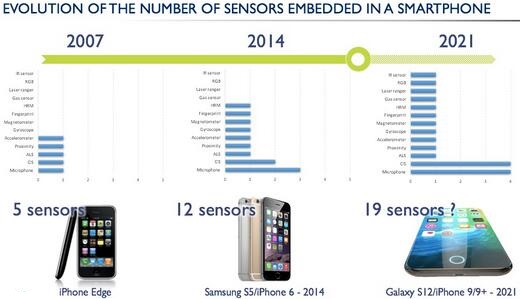
智能手機中集成的傳感器數量變化
我們的《應用於手機和平板電腦的傳感器-2016版》報告展現了競爭激烈的智能手機市場中傳感器的技術演進。目前,智能手機市場規模約為4500億美元,已經完成了第一段的快速增長期,面臨較低的利潤、平緩的銷售量等困境。傳感器,尤其是MEMS傳感器,是智能手機新技術革命的核心之一,具有顛覆性的能力。2007~2014年,智能手機中的傳感器數據將從5顆/部增至13顆/部,我們預計到2021年將增至19~20顆/部。
傳感器給智能手機市場帶來了“魔力”,使得人們願意為此購買新產品,以獲得新功能。我們認為,智能手機將在傳感器技術的發展驅動下,迎來一波新的增長。
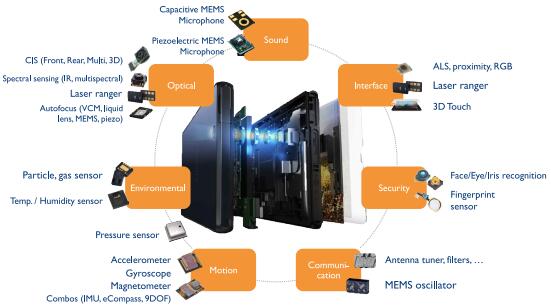
手機的價值主張- MEMS和傳感器的用途
應用於手機和平板電腦的傳感器市場將於2016年達到130億美元,仍有很多機遇
我們認為蘋果將會把3D感知技術應用於前置攝像頭中,要么使用雙攝像頭,要么使用額外的3D圖像傳感器。蘋果生來就致力於人機交互接口的創新,這一創新精神已經在蘋果的DNA中延續了35年。這家位於加州庫比蒂諾的公司一定已經全面考量過該技術的最新進展。該公司對Linx、Metaio以及Faceshift的收購案都表明,他們在幾年前就已經開始致力於開發並使用3D成像技術。在麥姆斯諮詢看來,就3D技術而言,時機恰到好處。蘋果公司憑藉創新型產品來推動其銷售也是無比正確的。
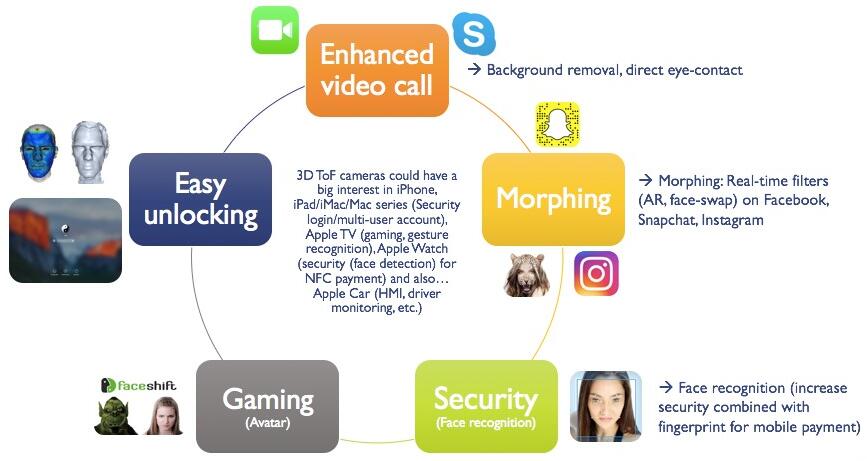
3D攝像頭:前置3D TOF攝像頭——蘋果的新機遇
目前市場上有很多廠商可以提供合適的傳感器,包括蘋果、AMS、意法半導體、SoftKinetic/索尼、PMD/英飛凌、Heptagon等。此前,蘋果還收購了美信(Maxim)位於美國加州聖何塞的8英寸Fab廠,並在法國“矽谷”——格勒諾布爾地區建立了研發團隊。這些舉措讓我們詳細,蘋果正在醞釀一個巨大的突破性技術——3D感知。
我們認為,利用3D感知技術可能改變Facetime及Skype等其它類似軟件的實時視頻通話體驗。VR(虛擬現實)頭戴式設備使移除背景、創建角色以及與通話者直接對視都成為可能,並且將可能引領一場真正的變革。
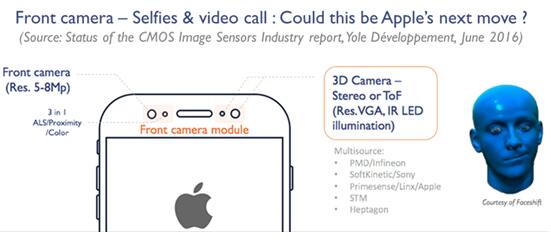
前置雙攝像頭-自拍&視頻通話:這會成為蘋果公司的下一個引爆點嗎?
另一個完美的例子支撐上述觀點的是:口袋精靈GO(Pokémon Go)遊戲的風靡,這款增強現實(AR)遊戲可以運行於蘋果iOS和安卓(Android),在全球範圍內實現了病毒式的廣泛傳播。但是也有許多報導該遊戲的用戶體驗取決於手機中現有的陀螺儀等傳感器性能,或是還未應用的3D感知技術。AR應用程序和3D感知的出現帶來了新機遇,展示了新的應用場景。人們將真切地感受到陀螺儀的性能對用戶體驗的影響;同樣地,3D攝像頭也將顯現其真實的價值。我們認為,智能手機市場還在尋找一些有價值的傳感器。蘋果正在對傳感器進行組合投資,以增強傳感器之間的協同作用。
智能手機產業正處於轉型期,領導廠商各盡其能、各展所長
憑藉在3D感知技術的佈局,蘋果將有機會再次“東山再起”。否則,“才華橫溢”的中國OEM手機廠商將可能成為“帶頭大哥”。三星將不會模仿蘋果的戰略,而是更側重於前端更新,如顯示器、存儲器和系統級芯片。中國的一些品牌廠商,如小米、360和TCL,仍處於一個低成本製造的商業模式,並時刻關注著蘋果的創新,以“物美價廉”吸引客戶。華為似乎是中國唯一一家充滿活力和自由,能夠快速執行創新技術的公司,儘管創新風險很大,但是值得稱讚和學習。隨著智能手機市場逐漸飽和,銷售量的提升愈發困難,其中一個解決方法就是顯著更新智能手機的使用場景。在這重要轉折時期,我們非常期待看到各大科技公司的各種創新能力,來充分挖掘智能手機的市場潛力。
Apple is under pressure. iPhone sales decreased from 108.7M units in the first half of 2015 to 91.6M units in the first half of 2016. There has never been a situation like this since the launch of the first iPhone. The Apple event on September 7th will partially unveil their mid-term strategy...
The company can no longer hide behind macroeconomic excuses and they now claim that competition has hugely increased, especially from Chinese players. That’s reflected by Huawei showing impressive 20% growth in 2016 and potentially reaching 120M units by the end of the year, which is beginning to steal Apple’s thunder. Even Apple’s nearest rival, Samsung, seems to have better momentum, powered by good sales of its S7 flagship.
Maybe it’s time for Apple to show what it is capable of?
Coming months should be turbulent for Apple
The waiting is huge… and the upcoming new iPhone appears to be more of an update rather than a makeover. Indeed, assuming the rumor mill is correct, the overall look of the iPhone 7, or perhaps the iPhone 6SE, is going to be extremely similar to the 6/6S. The main visual differences will be new colors, tidier antenna lines. The identifiable differences will be the removal of the 3.5mm headphone jack, bigger storage capacities and new cameras, with a larger lens on the smaller model, and dual cameras on the larger one. Those aesthetic refinements could arouse some disappointment for many people. Make no mistake, by adding dual cameras, Apple will greatly increase the image quality and the type of shots, fulfilling expectations of many photographers. This is also a brilliant marketing strategy to increase the average basket and margins on the larger model. The thing is, we are simply expecting something more disruptive from them to bring growth.
The new iPhone release will not show the new sensing technology we were talking about (See: The next step for Apple is not what you think). Yet, we may prove correct over a longer timeline. Indeed, Apple may have start to save time to fully develop their new technology by mimicking Intel’s strategy of going from a “Tick-Tock” to a “Tick-Tock-Tock” processor evolution model, jumping from a 2-year to a 3-year cycle.
One hypothesis could be that Apple may delay the true innovation something around the second week of next January and may unveil a new iPhone early in 2017 as they did for the first iPhone. Remember January 9, 2007? Steve Jobs came on stage to present what would become one of the greatest technological successes of all time. Approaching the 10th anniversary, we think that Apple has something big planned for their iconic iPhone, which has earned half of the company’s revenue since 2011. This could be the ideal time to start a new era.
New sensors to boost the market?
In our last report, “Sensors for cellphones and tablets 2016”, we gave our vision of past and future technological evolution of sensors in the highly competitive and valuable smartphone market, which is now worth $450B. The smartphone market may now have completed its first evolution phase, facing low interest from consumers and flattening sales in the main regions worldwide after years of insane growth. Sensors, and especially MEMS devices, were at the heart of this revolution, giving previously unsuspected capabilities to our phones. From 2007 to 2014, the number of sensors went from 5 to 13 per smartphone, and we expect this number to grow to 19, even 20 sensors in 2021.
Sensors bring the magic to the market, making people willing to buy new devices and get new abilities. We think that they can start a second phase of evolution, opening new use cases or enhancing existing ones.
The market for sensors in cellphones and tablets will reach $13B in 2016 – and that still offers a lot of opportunities
As we describe in our report (more), we believe that Apple will use 3D sensing technology either in its front facing cameras, or with a dual lens setup, or with an additional 3D image sensor. It has been in Apple’s DNA for 35 years now to innovate on the Human-to-Machine Interface side of computing. There is no way the recent advances in this field have not been fully taken into account by the famous Cupertino-based company. Its recent purchases, Linx, Metaio and more recently Faceshift, show that they have been working on the generation and usage of 3D imaging technology for a few years. From Yole’s point of view, the timing is right in terms of technology. Currently, many players can offer the right sensors, including: Apple, ams, STMicroelectronics, SoftKinetic/Sony, PMD/Infineon, or Heptagon. Apple has also acquired Maxim Integrated’s former fab in San Jose, California, and set up a team in Grenoble area, the French equivalent of Silicon Valley. These moves make us think that Apple is preparing a huge step forward, to use the next generation of sensors and cameras to capture the 3D space surrounding iPhone users. This innovative offering will provide Apple with a much-needed sales boost. We think that by leveraging 3D sensing technology it is now possible to transform the live video call experience in FaceTime and other Skype lookalikes. Being able to remove the background, morph your own face to share on social media or create avatars for roleplaying games, to look into the eyes of the caller while eventually using a VR headset has the potential to be truly transformative.
Another perfect example supporting this assumption is the huge impact of Pokémon Go, an augmented reality (AR) app for iOS and Android devices. This game has achieved unprecedented viral popularity worldwide, but there have been numerous reported cases of the user experience varying widely depending on the presence and quality of the gyroscope sensor or the lack of 3D perception of our smartphones. The emergence of AR apps and 3D perception brings new opportunities to show what technology can offer people. People will clearly see the impact of the quality of their gyroscope on their user experience. In the same way, 3D cameras will directly show their true value. We estimate that a large part of the market is still under-exploiting the value sensors can add. There are too many synergies with the sensors in Apple’s portfolio for them not to be investigating this one.
The smartphone industry is in transition, and the leader is wavering
We might be wrong with our assumptions, but this is clearly an opportunity for Apple to again outdistance its rivals. Otherwise, it could be an opportunity for a talented Chinese OEM to take the lead. Samsung will not deviate from its strategy of mimicking Apple and is more focused on the front-end operations such as display, memory, and systems-on-chips. Some Chinese brands, like Oppo, Xiaomi and TCL, are still in a low-cost fabrication business model, therefore offering few innovations to attract customers, monitoring Apple constantly as an innovation leader. Huawei seems to be the only one with the dynamism, freedom and rapid execution to make bets on innovative, albeit risky, paths with that could be particularly effective. With saturation of the smartphone market, increasing sales for the incumbent players will become extremely difficult and the only way to go might be to renew the smartphone use case significantly. We are at this cathartic moment when we should see the full innovation potential of those so-called technology companies.
Authors: Guillaume Girardin & Pierre Cambou from Yole Développement
Source: Sensors for Cellphones and Tablets 2016 report
In a global cellphone and tablet industry worth over $550B, sensors commanded US$12.2B in 2015, with 9.5% CAGR forecasted for 2015-2021.
Key features of the report: MORE
- Market forecast in $US, units, of systems sold through 2021
- Market forecast in $US, units, and wafer shipments of sensors through 2021
- Roadmap for technology evolution and future developments
- Estimated 2015 player market share by market segment
- Detailed application market forecasts through 2021
Discover analysis, reverse engineering on the same topic here
Contact for any question : jourdan@yole.fr






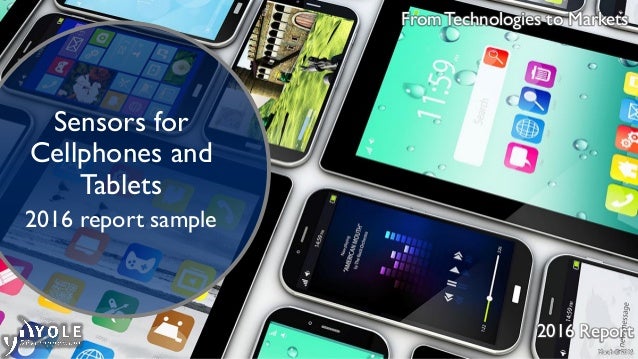



 留言列表
留言列表